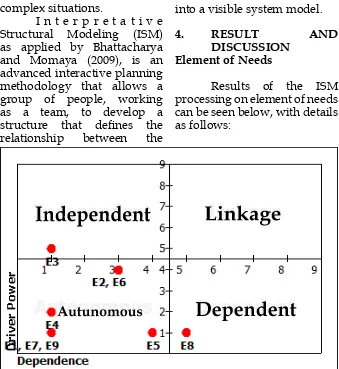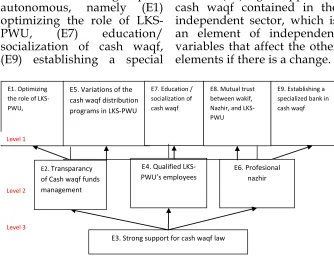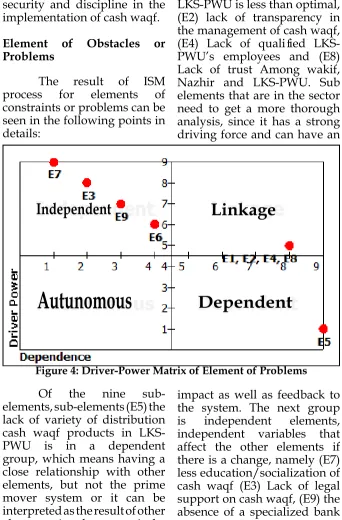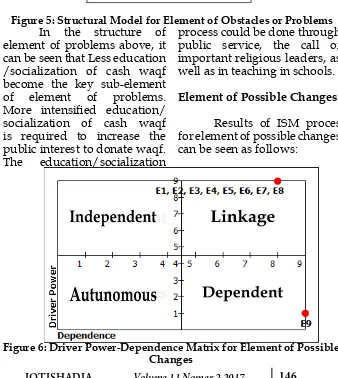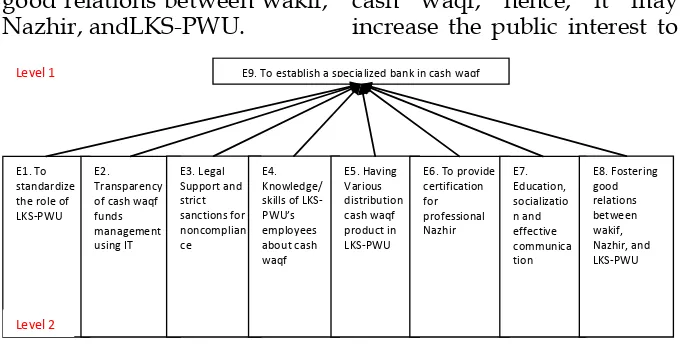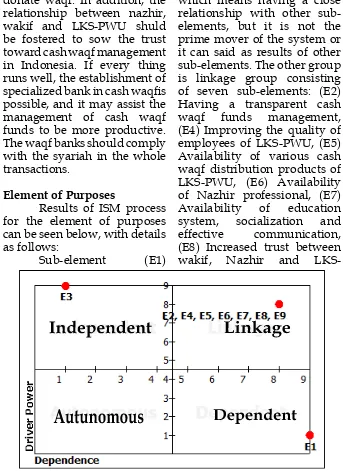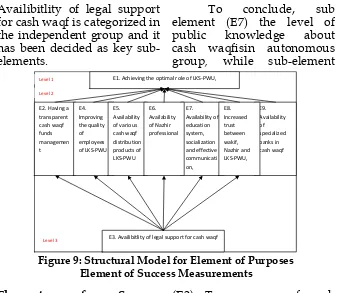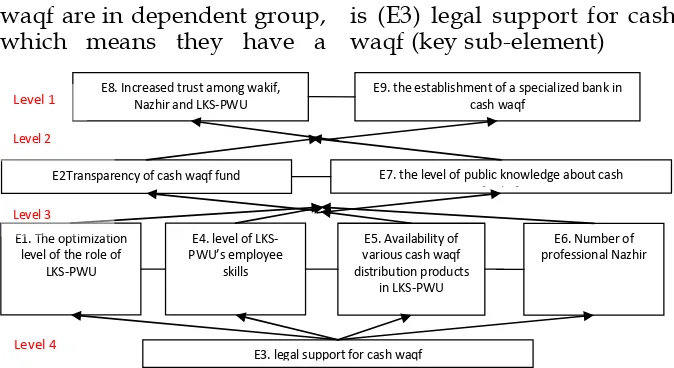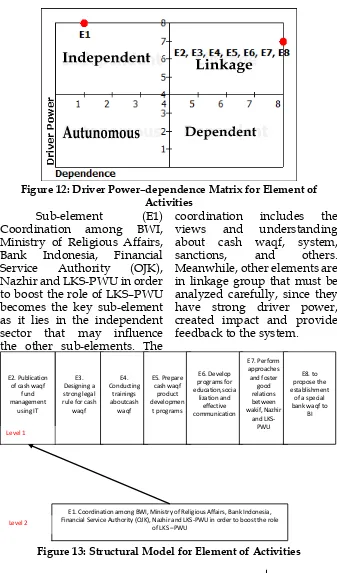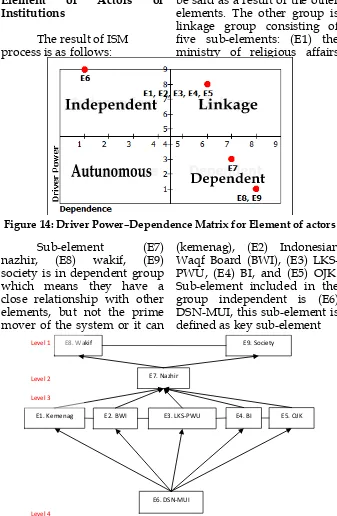EXPLORING
STRATEGIES TO
ENHANCE ISLAMIC
BANKING’S ROLE TO
RAISE CASH WAQF
FUNDS
Rizanti Khairunisa
Tazkia University College of Islamic Economics
Nashr Akbar
Tazkia University College of Islamic Economics
Abrista Devi
Ibnu Khaldun University
E-ISSN: 2502-3993 DOI:
Abstract
Cash Waqf funds has an important role to empower the economy of Ummah. Unfortunately, the collected cash waqf fund is still very small compared to its potential number. Against this background, this research aims to design systems that may enchance the role of Islamic banks in cash waqf fund raising. This paper employed Interpretative Structural Modeling (ISM) by conducting literature studies and In-depth interviews with some regulators, practitioners and academicians. The result shows that experts and practitioners agreed that the strong legal support on cash waqf is necessary to enhance the role of Islamic Banks to raise cash waqf funds. It creates a sense of secure to the stakeholders. Furthermore, it requires a strong coordination between Indonesian Waqf Board (BWI), Ministry of Religious Affairs, Bank Indonesia (BI), Financial Services Authority (OJK), Nazhir and Islamic Financial Institutions that may receive cash waqf (LKS-PWU) in order to boost the role of Islamic Banks. The main obstacle that must be tacled soon is the lack of education about cash waqf.
Keywords: Cash Waqf, Interpretative Structural
Modeling, LKS-PWU
Abstrak
Wakaf uang memiliki peran penting untuk
memberdayakan ekonomi umat. Sayangnya,
jumlah dana wakaf uang yang berhasil terkumpul
masih sangat kecil bila dibandingkan dengan nilai
potensinya. Atas dasar ini, penelitian ini bertujuan
untuk merancang sistem yang dapat meningkatkan
peran bank syariah dalam menghimpun wakaf
(regulator), praktisi dan akademisi. Pendekatan ISM yang digunakan mengacu kepada Saxena, di mana terdapat 9 elemen ISM, diantaranya adalah kebutuhan, masalah, kemungkinan untuk perubahan, tujuan, indicator sukses, kegiatan, pelaku, komunitas yang berpengaruh,
dan pengukuran efektiitas. Hasil penelitian
menunjukkan bahwa para ahli dan praktisi sepakat akan pentingnya dukungan hukum yang kuat untuk meningkatkan peran bank syariah
dalam menghimpun wakaf uang. Hal tersebut
dapat memberikan rasa aman bagi para pemangku kepentingan. Lebih lanjut, dibutuhkan koordinasi
yang lebih kuat antara BWI, Kementrian Agama, BI,
OJK, Nazhir and LKS-PWU guna meningkatkan
peran bank syariah. Kendala utama yang mesti juga diselesaikan adalah lemahnya edukasi
tentang wakaf uang.
Kata Kunci: Wakaf Uang, Interpretative Structural
1. INTRODUCTION
The understanding of
Indonesian people towards
waqf is still limited to the object of waqf which is
immobile, such as land and building. This may cause lack
of people’s interest to donate his wealth as waqf. In essense, waqf is not only limited to
immobile properties, but also mobile properties, such
as cash waqf. Cash waqf is
a new innovation in Islamic
inancial system for voluntary
sector. This instrument is able
to solve the rigidity of waqf
institution in Muslim countries
and offer a great opportunity to the development of social economy of ummah in a whole.
It also provides opportunity to
the whole society to perform waqf in a smaller amount.
In May 11, 2002, Fatwa
commision of Indonesian
Ulama Council has issued a
fatwa on cash waqf. It stated as follows: (1) cash waqf/waqf al-Nuquud is a waqf performed
by an individual, community, instittuition and legal body in
the form of cash money, (2)
cash includes securities, (3)
cash waqf is permissible, (4) Cash waqf should be allocated and used only for anything
which complies shariah, (5)
principal value of cash waqf should be maintained for its
sustainaibility; cannot be sold,
given to others and inherited.
According to Nasution (2012), the potency of cash waqf in Indonesia is huge. He illustrated that if 20 million of
Muslims donate their wealth
as waqf for one million per year, then, the potency for collected waqf fund can reach 20 Trilllion. Therefore, it is necessary to have professional waqf institutions thay may manage those funds. The act no. 41 year 2004 about waqf can
be used as a basis to develop
cash waqf management, where
various parties including government, Islam Ummah,
Indonesian Waqf Board (BWI) and Islamic inancial
institutions can work together
to develop waqf management
in Indonesia.
Based on the act No. 41 year 2004 article 28 to 31,
cash waqf funds should be paid through Islamic inancial
institution approved by
minister of religious affair of
Indonesia (RI). The ministry has approved 15 Islamic banks
to be Cash waqfrecepients
Syariah, BPD Sumut Syariah, Bank CIMB Niaga Syariah dan Panin Bank Syariah. (Basyuni, 2015)
Unfortonutely, the contribution of cash waqf through Islamic inancial Instituion-Recipient of Cash Waqf (LKS-PWU) is not
more than Rp 4.115.827.570,- (Basyuni, 2015, p.15). This
amount is far from its potency.
The gap between potency and the realisation indicates that
cash waqf in Indonesia has not
been managed at optimum yet.
Research conducted by Farhah, et al (2014) stated that
cash waqf has an important role for poverty alleviation in a country. Cash waqf is also useful for middle income
society in contributing to
pay waqf. However, the improvement of cash waqf
practices still need high support
from the government. Another
study is also well conducted by Ibrahim, et al (2013) where
cash waqf will raise properly with high commitment from
the authority, scholars, and
Figure1:Collected Cash Waqf of BWI Through Islamic Banks Per
31 December 2014
ummah (society). Haron, et al (2016) investigated the
potential factors to inluence cash waqf collection. The main factors to inluence waqf collection are promotion, staffs, method, place of collection
and authority. Rusdiyana and Devi (2014) proposed some
strategies after identifying cash waqf problems: 1) more
computer-based management,
2) developing waqf education
institutions, 3) improving the
quality of fund managers,
and 4) transparency and accountability in every stage
of waqf management.
However, those
afformentioned studies have not identiied the main basic elements to enhance the role of
Islamic banks in order to collect
cash waqf. Therefore, this research aims to identify key
elements and then construct some strategies that may help Islamic banks to raise more
cash waqf funds.
2. L I T E R A T U R E REVIEW
Cizakca (1998) stated
that cash waqf has a great
potency. Moreover, he
proposed the integration of cash waqf and mudharabah in the banking portfolios. Cash waqf which is perpetual in
nature is expected to solve the
missmatch liquidity of Islamic banks in long-term. Takaful
is necessary to maintain
the value of cash waqf.
Furthermore, Sabit (2011)
argued the permissibilty of
establishing a bank on the
basis of waqf, where waqf funds can be used as capital
similar to the common banks.
Nais (2011) studied the implementation of cash waqf in Indonesia. He found that the collected waqf funds should be allocated by
nazhir into various business sectors which comply shariah (halal) and productive. The
funds can be invested in the products of Islamic inancial
No LKS-PWU % Kontribusi Wakaf Uang
institutions. The investment will be protected by Islamic insurance.
In relation to Islamic Financial institution, Zamhari (2011) did a research on the
implementation of Islamic
Financial Intsitutions in
developing cash waqf in
Indonesia. The result shows
that the role of Islamic inancial institution (LKS) in developing cash waqf
has a strong legal basis as stipulated in the act No. 41 year 2004. Besides, LKS has a wide network, compatible human resources, and Deposit Insurance Corporation that
guarantee the safety of waqf funds. However, there are some challenges: lack of nazhir, the dificulty of
LKS-PWU to the explain to the
prospective waqif about the real project, different
understanding among LKS-PWU, BWI and Kemenag about some points in the
codes of conduct. In relation
to those challeges, BWI and LKS-PWU need to synergize
in the waqf socialization to
the whole society.
Furqon (2011)
analyzed the practice of cash waqf in Islamic inancial
institutions, especially in Bank SyariahMandiri. He made some conclusion
from his study; 1) the dissemeniation of cash waqf
is relatively limited, 2) BSM
has no a speciic counter that
may serve customers who is willing to register/donate
cash waqf, 3) there are two investment models for cash waqf in the bank: investment
in real sectors such as buildng a maternity hospital, and
in inancial sectors, where the funds are depositied in the term deposits of bank
syariahmandiri.
In relation to the small
number of waqf collection,
Mikail (2013) argued that it
is due to lack of support and participation of government.
Siswantoro and Dewi (2011)
argued that ineffectiveness of cash waqf institutions is caused by, 1) lack of
government support, 2) the
understanding of people about waqf is still limited to
physical asset.
Rusdiyana and Devi (2014) studied the problems
of cash waqfmanagement in Indonesia. They found four
basic problems: 1) Human aspect, 2) Trust aspect, 3) System aspect and 4) Shariah
aspect. Using ANP method,
the result shows that the main problem is trust (most priority), then shariah, human resource and last is system.
Therefore, they proposed some strategies as follwos: 1)
management with computer
education institutions, 3)
increasing the ability of
nazhir, 4) transparancy and accountability in every stage
of wqaf management.
Ubaid (2014) analyzed
the result and method of fundraising cash waqf of BWI. He found that the performance of BWI in collecting funds is
instable (up and down). This is due to working rhythem
of BWI. Compared to other nazhirs, the amount of cash waqf collected by BWI is lower. Therefore, BWI must
consider to use other methods
to fundraise at maximum. Of
the methods are collecting
funds from membership, offering letter through direct
email, employing voluntary
labor force, and utilize the funds of the company.
Moreover, BWI should create a special division assigned to
fundraise cash waqf.
Mu’allim and
Abdurrahman (2014)
proposed cash waqf as a tool
that may increase people’s
welfare. Cash waqf can be
utilized as a new source to activate potential economy
emporwment sectors. Even though, there are still
many challenges in the implementation, hence, cash
waqf should be developed by
strengthening the regulation, institutions, and cooperation with other institutions.
Osman et al (2012) studied variables that may
inluence the willingness of people to make a waqf
donation. By doing literature
survey, they found six factors at least: 1) spiritual satisfaction, 2) understanding about waqf,
3) trust, 4) demography, 5)
ineficient management, 6) tax
incentives.
Al-Arif (2010)
explored about community empowerment through
cash waqf. He argued that cash waqf has a signiicant
role to design community empowerment programs. He emphasized that community
empowerment is not a task of
government only, but every
segment of community must
participate in the economic empowerment. The collection
and management of cash waqf can be integrated with Islamic inancial institutions.
Nazhir is assigned to invest
those funds in the projects
wich comply shariah with one requirement: the nominal
value of cash waqf invested
should be maintained, not
3. METHODS
Source and Methods of Data Collection
The data used in this research is primary data
obtained from interviews with
experts and practitioners. Selected respondents are those who are considered to have a good understanding
of cash waqf development
in Indonesia and those who
work for the LKS-PWU and waqf regulators (BWI and the Ministry of Religious Affairs). The ‘group’ of respondents was
designed to be unconventional
in its deined criteria. The criteria for respondents from
the practitioners group are: 1) the respondents have been
working for the LKS-PWU and
have main job descriptions involving collecting cash
waqf; 2) the respondents
must also have experience
of collecting cash waqf;
and 3) the respondents are considered knowledgeable about the role the LKS-PWU
plays in collecting cash waqf. The criteria for respondents from the regulator group
are: 1) the respondents
are involved in cash waqf
regulation development; 2) the respondents are considered knowledgeable about the role the LKS-PWU plays in
collecting cash waqf; and 3) the
respondents are considered
to have written or spoken publicly on at least one theme
regarding the role of LKS-PWUs in collecting cash waqf. After identifying the criteria of each group
respondent, nine respondents are selected. There is no maximum or minimum requirement in choosing a respondent, the most important thing to be considered is that they must have expertise in the discussed topic.
Beside interviews, this research also studied literatures dealing with the problems encountered in the
implementation cash waqf funding. Some sub-elements of Strategies to strengthen the Role of Islamic Banks in collecting cash waqf are obtained from the literatures
and discussion. Those strategies will be expressed
in the form of a questionnaire by using the approach of
Interpretative Structural
Modeling (ISM), referring to
Saxena with his nine elements, namely needs, constraints or problems, possible changes,
goals, benchmarks of success,
activities, actors (stakeholders),
affected communities, and measures of effectiveness.
Interpretative Structural
Modeling (ISM) is a modeling
technique developed for
planning strategic policies (Marimin: 2004). ISM was
irst invented by J. Warield in 1973, where Warield deines
the ISM as computer-assisted learning process that allows individuals or groups to
develop a map of the complex
relationship between the various elements involved in complex situations.
I n t e r p r e t a t i v e Structural Modeling (ISM) as applied by Bhattacharya and Momaya (2009), is an advanced interactive planning methodology that allows a
group of people, working
as a team, to develop a
structure that deines the
relationship between the
elements in a set. Structures obtained by answering simple questions. Elements that will be structured (such as goals, obstacles, problems, and
so on) are speciied at the beginning of the ISM planning
session. ISM process starts at the modeling system and
ends with the validation of
the model. Through the ISM techniques, raw models that
are not clear is transformed
into a visible system model.
4. RESULT AND
DISCUSSION Element of Needs
Results of the ISM processing on element of needs
can be seen below, with details
as follows:
Six sub-elements
are included in a group of
autonomous, namely (E1)
optimizing the role of
LKS-PWU, (E7) education/
socialization of cash waqf,
(E9) establishing a special
bank in cash waqf, (E5) Variations of the cash waqf
distribution programs in
LKS-PWU (E4) Qualiied
LKS-PWU’s employees, (E2)
transparancy of Cash waqf funds management, while (E6) Professional Nazhir,
a sub-element which is connected to the system. Sub-element (E8) mutual trust
between wakif, Nazhir and
LKS-PWU is in the dependent group, which means having a close relationship with other elements, but not the
prime mover of the system
or it can be interpreted as the
result of other elements. Sub-element (E3) legal support for cash waqf contained in the
independent sector, which is
an element of independent variables that affect the other elements if there is a change.
The above igure shows the sequence of stages of needs in the implementation of the strategy to enhance the role of
Islamic banks in the collection
of cash waqf. The lowest level,
level 3, is the key sub-element
of the elements of needs, means strong legal support for cash waqf has the most impact. Cash waqf law has been
resolved, but there are still
a lot of confusion regarding
boundaries, systematic cash
waqf, sanctions for those who
do breach the rules. It requires
the irmness on the law in order to create a sense of E1. Optimizing
the role of LKS-PWU,
E5. Variations of the cash waqf distribution programs in LKS-PWU
E7. Education / socialization of cash waqf
E8. Mutual trust between wakif, Nazhir, and LKS-PWU
E9. Establishing a specialized bank in cash waqf
E4. Qualified LKS-PWU’s employees
E6. Profesional nazhir
E3. Strong support for cash waqf law
Level 1
Level 2
Level 3
E2. Transparancy of Cash waqf funds management
security and discipline in the
implementation of cash waqf.
Element of Obstacles or Problems
The result of ISM process for elements of
constraints or problems can be
seen in the following points in
details:
Of the nine
sub-elements, sub-elements (E5) the
lack of variety of distribution cash waqf products in
LKS-PWU is in a dependent group, which means having a close relationship with other elements, but not the prime mover system or it can be
interpreted as the result of other elements. Another group is the linkage, there are four sub-elements namely (E1) role of
LKS-PWU is less than optimal,
(E2) lack of transparency in the management of cash waqf, (E4) Lack of qualiied
LKS-PWU’s employees and (E8)
Lack of trust Among wakif,
Nazhir and LKS-PWU. Sub elements that are in the sector need to get a more thorough analysis, since it has a strong
driving force and can have an
impact as well as feedback to
the system. The next group is independent elements, independent variables that
affect the other elements if
there is a change, namely (E7)
less education/socialization of cash waqf (E3) Lack of legal support on cash waqf, (E9) the absence of a specialized bank in cash waqf, and ( E6) the lack of professionalism of Nazhir.
In the structure of element of problems above, it
can be seen that Less education
/socialization of cash waqf
become the key sub-element
of element of problems. More intensiied education/ socialization of cash waqf
is required to increase the
public interest to donate waqf.
The education/socialization
process could be done through
public service, the call of
important religious leaders, as well as in teaching in schools.
Element of Possible Changes
Results of ISM proces for element of possible changes can be seen as follows:
Figure 6: Driver Power-Dependence Matrix for Element of Possible
E5. lack of variety of distribution cash waqf programs in LKS-PWU
E1. Role of LKS-PWU is less than
optimal
E2. lack of transparency in the management of
cash waqf
E4. Lack of qualified LKS-PWU’s employees
E8. lack of trust between wakif, Nazhir and LKS-PWU
E6. Lack of professional Nazhir
E9the absence of a specialized bank in cash waqf E3. Lack of legal support on cash waqf E7. Less education /socialization of cash waqf
Level 1
Level 2
Level 3
Level 4
Level 5
Level 6
Of those nine
sub-elements, sub-element (E9) To establish a specialized bank in
cash waqf is in the dependent
group, which means has a
close relationship with other elements, but not the prime
mover of the system or it can be said the result of other
elements. The next group is linkage, there are eight sub-elements in this group namely (E1) To standardize
the role of LKS-PWU, (E2) Transparency of cash waqf funds management using IT,
(E3) Legal Support and strict
sanctions for non-compliance, (E4) Knowledge/skills of
LKS-PWU’s employees about cash
waqf, (E5) Having Various distribution cash waqf product
in LKS-PWU, (E6) To provide
certiication for professional
Nazhir, (E7) Education,
socialization and effective
communication, (E8) Fostering
good relations between wakif,
Nazhir, andLKS-PWU.
The above element
structure model of possible changes show the need of standardization of the role of LKS-PWU in order to improve the performance of LKS-PWU to fundraise cash waqf to be more eficient.
Besides, transparancy in the
management of cash waqf
can be done by publication in the website, magazines and others. Transparancy may
bring a secure feeling and trust toward nazhir for managing cash waqf. The use of IT for
transparancy is necessary to provide systemation
information to the communities about the management of cash waqf every month. To provide certiication for professional
nazhir can be considered as an appreciation to the good
performance of nazhir. A professional nazhir should be
able to educate people about
cash waqf, hence, it may
increase the public interest to
E9. To establish a specialized bank in cash waqf
E1. To Support and strict sanctions for noncomplian ce
E4. Knowledge/ skills of LKS-PWU’s employees about cash waqf
E5. Having Various distribution cash waqf product in LKS-PWU
E8. Fostering good relations between wakif, Nazhir, and LKS-PWU
Level 1
Level 2
donate waqf. In addition, the
relationship between nazhir,
wakif and LKS-PWU shuld be fostered to sow the trust toward cash waqf management in Indonesia. If every thing runs well, the establishment of specialized bank in cash waqis
possible, and it may assist the
management of cash waqf funds to be more productive. The waqf banks should comply
with the syariah in the whole transactions.
Element of Purposes
Results of ISM process for the element of purposes
can be seen below, with details
as follows:
Sub-element (E1)
Achieving the optimal role of LKS-PWU is classiied
in the dependent group
which means having a close relationship with other sub-elements, but it is not the
prime mover of the system or it can said as results of other
sub-elements. The other group is linkage group consisting
of seven sub-elements: (E2)
Having a transparent cash
waqf funds management, (E4) Improving the quality of employees of LKS-PWU, (E5) Availability of various cash waqf distribution products of LKS-PWU, (E6) Availability of Nazhir professional, (E7) Availability of education
system, socialization and
effective communication,
(E8) Increased trust between
wakif, Nazhir and
LKS-PWU, (E9) Availability of specialized banks in cash waqf.
Meanwhile, sub-element (E3)
Availibitlity of legal support for cash waqf is categorized in
the independent group and it has been decided as key sub-elements.
Element of Success Measurements
Results of processing
element success measurements can be seen below:
To conclude, sub
element (E7) the level of
public knowledge about
cash waqisin autonomous
group, while sub-element
(E2) Transparency of cash waqf fund management,
(E8) Increased trust among
wakif, Nazhir and
LKS-PWU, (E9) the establishment
of a specialized bank in cash
Figure 10: Driver power–dependence Matrix for Element of Success measurements
Figure 9: Structural Model for Element of Purposes Element of Success Measurements
E3. Availibitlity of legal support for cash waqf E2. Having a the quality of employees of LKS-PWU
E5. Availability of various cash waqf distribution products of LKS-PWU
E7. Availability of education system, socialization and effective communicati Nazhir and LKS-PWU, E6.
Availability of Nazhir professional
E1. Achieving the optimal role of LKS-PWU, Level 1
Level 2
waqf are in dependent group,
which means they have a
close relationship with other elements, but not the prime
mover of the system or it can be said as a result of the
other elements. Third group is
linkage group. There are four
sub-elements in the group;
(E1) The optimization level of the role of LKS-PWU, (E4) the level of LKS-PWU’s employee skills, (E5) Availability of various cash waqf
distribution products in LKS-PWU, and dan(E6) Number
of professional Nazhir. Sub
elementsin the group must
be analyzed more carefully,
because it has a strong driving
force and can have impacts as well as feedback to the system. The fourth group is
independent elements that
may affect the other elements if there is a change.
Sub-element included in the group
is (E3) legal support for cash waqf (key sub-element)
The key sub-element
of success measurement is the legal support for cash waqf. The legality of cash waqf has been issued since
2004, but the problem lies in
the absence of strict sanction for those who break the law,
hence, the legal support must be more strengthened. With strong legal support, the other sub-elements will be achieved easier.
Element of Activities
Results of processing
the elements can be seen
below, with details as follow: E8. Increased trust among wakif,
Nazhir and LKS-PWU
E9. the establishment of a specialized bank in cash waqf
E2Transparency of cash waqf fund management
E7. the level of public knowledge about cash waqfwakafuang
E1. The optimization level of the role of
LKS-PWU
E4. level of LKS-PWU’s employee
skills
E5. Availability of various cash waqf distribution products
in LKS-PWU
E6. Number of professional Nazhir
E3. legal support for cash waqf
Level 2
Level 3 Level 1
Level 4
Sub-element (E1) Coordination among BWI,
Ministry of Religious Affairs,
Bank Indonesia, Financial
Service Authority (OJK),
Nazhir and LKS-PWU in order
to boost the role of LKS–PWU
becomes the key sub-element as it lies in the independent
sector that may inluence
the other sub-elements. The
coordination includes the views and understanding
about cash waqf, system,
sanctions, and others. Meanwhile, other elements are in linkage group that must be
analyzed carefully, since they
have strong driver power, created impact and provide
feedback to the system.
Figure 12: Driver Power–dependence Matrix for Element of Activities
E2. Publication of cash waqf
fund management
using IT
E3. Designing a strong legal rule for cash
E5. Prepare cash waqf
product developmen
t programs
E6. Develop programs for education,socia
lization and effective communication
E7. Perform approaches and foster
good relations between wakif, Nazhir
and LKS-PWU
E8. to propose the establishment
of a special bank waqf to
BI
E1. Coordination among BWI, Ministry of Religious Affairs, Bank Indonesia, Financial Service Authority (OJK), Nazhir and LKS-PWU in order to boost the role
of LKS –PWU
Level 1
Level 2
Element of Actors or Institutions
The result of ISM process is as follows:
Sub-element (E7)
nazhir, (E8) wakif, (E9)
society is in dependent group which means they have a close relationship with other elements, but not the prime
mover of the system or it can
be said as a result of the other
elements. The other group is
linkage group consisting of ive sub-elements: (E1) the ministry of religious affairs
(kemenag), (E2) Indonesian
Waqf Board (BWI), (E3)
LKS-PWU, (E4) BI, and (E5) OJK. Sub-element included in the group independent is (E6) DSN-MUI, this sub-element is
deined as key sub-element
E6. DSN-MUI
E8. Wakif E9. Society
E7. Nazhir
E1. Kemenag E2. BWI E3. LKS-PWU E4. BI E5. OJK
Level 1
Level 2
Level 3
Level 4
Figure 15: Structural Model for Element of Actors
Nazhir plays an important role to enhance
the collection of cash waqf funds. Nazhir must have high
intellectual capability about
waqf and have a special ability
to manage investments. Nazhir is able to pursue people to
donate his waqf funds through
registered LKS-PWU by doing intense socialization to the
potential waqif. Kemenag,
BWI, LKS-PWU, BI, OJK coordinate to supervise the
development of cash waqf fundraising. DSN-MUI acts
as shariah supervisor and a
mediator of misunderstanding
between related parties.
Element of Affected People Segment
Results of ISM process
can be seen below:
Sub-element (E3) Islamic Financial
Institutions-Cash Waqf Recipients (LKS-PWU), (E7) nazhir, (E8) wakif,
(E9) society is in dependent group which means they have a close relationship with other elements, but
not the prime mover of the
system or it can be said as a
result of the other elements.
The other group is linkage
group consisting of four sub-elements: E1) Ministry of Relegious Affairs (kemenag), (E2) Indonesia Waqf Board
(BWI), (E4) Bank Indonesia (BI), dan (E5) Financial
Service Authority (OJK). Sub-element of independent group is
(E6) DSN-MUI, deined as key
sub-element.
The inluence of
DSN-MUI is very storng to the
sustainibility of cash waqf
in Indonesia. The issuance
of fatwa on May 11, 2002 about cash waqf has been the main legal basis of cash waqf. Kemenag, BWI, BI, and
OJK must coordinate to make
regulations for the sustainibility of cash waqf and appoint
LKS-PWU as institutions thay may
receive cash waqf investment
to be saved in demand deposits
account or time deposit account. Next, nazhir acts to persue
people to donate in the form of cash waqf. Mutual cooperation
among the involved parties is required to support the success
of cash waqf.
Element of Effective Measurements
Results of ISM process is as follows:
E6. DSN-MUI
E8. Wakif E9. Society
E7. Nazhir
E1. Kemenag E2. BWI
E3. LKS-PWU
E4. BI E5. OJK
Level 2
Level 3
Level 4
Level 5 Level 1
Figure 17: Structural Model for Element of Affected People Segment
Sub-element (E1) The
achievement of optimal role of LKS-PWU is in dependent
group which means they have a close relationship with other elements, but not the prime
mover of the system or it can be said as a result of the other
elements. The other group is
linkage group consisting of
seven sub-elements: (E2) The
transparency of cash waqf fund management, (E4) the availibity of skills training programs for employees of LKS-PWU, (E5) Availability of various distribution cash waqf product of LKS-PWU, (E6) Certiication of proffesional Nazhir, (E7) The availibity of cash waqf socialization and
communication programs,
(E8) The existence of trust between wakif, Nazhir and
LKS-PWU, (E9) The existence
of a specialized bank in cash waqf. Sub-element (E3) the
existence of legal support for cash waqf contained in the
independent sector, which is
an element of independent variables that affect the other elements if there is a change.
The existence of legal support for cash waqf is the
key sub-element. Strong legal protection may create a
sense of safety to those who assist the collection of cash waqf. The effectiveness of
this strategy can be achieved
when the transparency of cash waqf funds management
exists, when skills training
programs for employees of
LKS-PWU conducted, when
various distribution cash waqf products have been offered by LKS-PWU, when proffessional nazhir is certiied, when the program of socialization and communcation of cash waqf
is conducted, when mutual
trust among wakif, nazhir and
E1. The achievement ofoptimal role of LKS-PWU
E2. The transparency
ofcash waqf fund management
E4. the availibity of
skills
E5. Availability of various distribution
cash waqf product of LKS-PWU
E6. Certification of proffesional
Nazhir
E7. The availibity of
cash waqf
E3. The existence of legal support for cash waqf contained in the independent sector
E9. The
LKS-PWU exists, and when a
spesialized bank in cash waqf
is established.
Key Sub-elements of Strategy to Enhance the Role of Islamic Banks to Fundraise Cash Waqf
Key Sub-elements is a sub-element used as a
driving force, which is in its
implementation need to be considered, because it can
affect the success or failure of other sub-elements. The
major key sub-elements in this
study is the need of strong legal support for cash waqf as the optimalization of Islamic banks’ role to receive cash waqf
is very much dependent on it. Mikail (2013) and Siswantoro & Dewi (2011) argued that
the lack of support and participation of government cause ineffectiveness in waqf
collection. Mu’allim and
Abdurrahman (2014) also
recommended to strengthen the
waqf regulation, institutions,
and cooperation in order to
develop cash waqf. The current system to conduct cash waqf
is still unclear as some parties
have difference perceptions in waqf management. Hence, it
requires a strong coordination between BWI, Kemenag, BI, OJK, Nazhir and LKS-PWU in
order to boost the role of
LKS-PWU. They must have same
the ego of each institution.
Furthermore, in the
elements of possible change, no prime mover is found in
the system. Eight sub-elements are in the linkage group, which means they must be interrelated and then it must be implemented in the same time. Those sub-elements are
standardization of the role of
LKS-PWU which is based on the
coordination among cash waqf
stakeholders, transparency in
the management of cash waqf funds using IT, knowledge/ expertise of LKS-PWU’s employees about cash waqf,
variations in the distribution
cash waqf products available
in LKS-PWU, providing
certiication for professional
Nazhir, education,
socialization and effective communication, and fostering good relations between wakif,
Nazhir and LKS-PWU.
The prime mover
obstacle is the lack of
socialization and education
about the cash waqf. So far,
public perception about
cash waqf is still minimum. Therefore, it requires a movement of dissemination
to the public through the mass media publications, advertising, early education
about cash waqf and others.
Some people still perceive
and Dewi, 2011). Haron et al. (2016) argued that the government should increase
their promotion efforts to raise the awareness of the wakif. They found that promotion
and human resources are the
main factors inluencing cash waqf collection. Likewise,
Harun et al. (2016) and Huda et al. (2012) also strongly suggested to have a more solid promotion programme that may increase awareness about
waqf. in this case, Rusdiyana
and Devi (2014) revealed the
need to increase the ability of
Nazhir and to build a special
institution in waqf education.
Besides, the DSN-MUI has an important role in
inluencing the public, with the release of fatwa of MUI about cash waqf on May 11, 2002. The fatwa became a strong legal foundation and give full
support to the advancement
of cash waqf in Indonesia.
DSN-MUI is also tasked with observing the sustainability
of cash waqf and to mediate between the parties involved if
misunderstanding occurs.
5. CONCLUSSION
Summary
The role of Islamic banks in the cash waqf management
according to the law no. 41 year
2004 on waqf is as a recipient of cash waqf. Nazhir who collects
cash waqf should deposit it
in LKS-PWU to be invested
in inancial investments. The collected cash waqf could be in
perpetual or in limited term. Using ISM method, the
research inds that the main key
sub-elements is a strong legal
support for cash waqf. Experts
and practitioners agreed that
legal support creates a sense of
secure to those who involved
in the cash waqf fundraising.
In this case, the clarity system
cash waqf is still unclear,
since some parties have
misperception of cash waqf.
Hence, it requires a strong coordination between BWI, Kemenag, BI, OJK, Nazhir and LKS-PWU in order to boost the
role of LKS-PWU. They must
have same perception and do
not prioritize the ego of each
institution.
The most important actor is DSN-MUI since the whole activities must be compliant with sharia. Moreover, the most priority obstacle that must be solved
is the lack of education/ socialization about cash waqf.
Recommendations
There are some
recommendations for the stakeholders of cash waqf.
First, Strengthening the
LKS-PWU and nazhir. Second, designing an integrated
information system thay
may be monitored by BWI, Kemenag, nazhir and LKS-PWU. The system should also be able to help transparancy
of cash waqf management towards people as waqif. Third,
Cash waqf programs must be
more promoted. Government
may initiate salary deduction
for civil servants and employees of state-owned enterprises to pay waqf even
in a small amount. Fourth,
LKS-PWU should provide a
References
Al-Arif. (2010). Pemberdayaan Masyarakat Berbasis Wakaf
Uang. Jurnal Asy-Syir’ah Fakultas UIN Sunan Kalijaga
Yogyakarta, Vol. 44 No. II, pp. 813 - 828.
Ascarya, Gunadi, W., Cahyono, W.,Anwar, E., and Syarifuddin,
F.(2012). Strategi Meningkatkan Preferensi Perbankan
Syariah Indonesia Dalam Menggunakan Pembiayaan Bagi-
Hasil. Jakarta: Central Banking Education and Studies
Department, Bank Indonesia.
Aula, M.A. (2012). Pemberdayaan Umat Melalui Lembaga Wakaf. Jurnal Al-Awqaf, Vol. V, No. 2.
Basyuni, M. (2015). Pengembangan Wakaf Korporasi Di Indonesia.
Paper presented at Seminar Nasional Ekonomi Syariah, Ruang Rekreasi, Bank Indonesia, Jakarta, 30 Maret.
Bhattacharya, S., and Momaya, K. (2009). Interpretive Structural
Modeling of Growth Enablers in Construction Companies.
Singapore Management Review, Vol. 31, No. 1, pp. 73-97.
Cizakca, M. (1998).Awqaf in History and Its Implications for
Modern Islamic Economies.Islamic Economic Studies, Vol
6, No 1,pp. 43-70.
Djunaedi, A, and Indra. (2015). Wawancara Wakaf Uang.
BadanWakaf Indonesia, Jakarta, 21 April 2015.
Furqon. (2011).Analisis Praktek Perwakafan Uang Pada
Lembaga Keuangan Syariah. Jurnal Walisongo, Vol. 19 No
1 pp. 157-178.
Haron, M., Kamarudin, M.K., Fauzi, N.A.M., Ariff, M.M., and Zainuddin, M.Z. (2016). International Journal of Business,
Economics, and Law, Vol 9, Issue 2, pp 27-33.
Ibrahim, H., Amir, A., and Masron, T.A. (2013). Cash Waqf: An Innovative Instrument for Economic Development. International Review of Social Sciences and Humanities,
Vol 6, No 1, pp 1-7.
Ministry of Religious Affairs of the Republic of Indonesia. (2006).
Fiqih Wakaf. Jakarta.
_________________________________________________. (2012). Himpunan Peraturan Perundang-Undangan Tentang Wakaf. Jakarta: Direktorat Jenderal Bimbingan Masyarakat Islam
Direktorat Pemberdayaan Wakaf.
_________________________________________________. (2013).
Strategi Pengembangan Wakaf Tunai di Indonesia. Jakarta:
Direktorat Jenderal Bimbingan Masyarakat Islam
Direktorat Pemberdayaan Wakaf.
Marimin.(2004). Teknik dan Aplikasi Pengambilan Keputusan
Kriteria Majemuk. Jakarta: Grasindo.
Mikail. (2013). Perspective Of SiyasahShar’iah In Application Of
Cash Waqf Transfer For Islamic Financial Industry: Indonesian
Study Case, Paper Proceeding of the 5th Islamic Economics
System Conference (iECONS 2013), “Sustainable
Development Through The Islamic Economics System”, UniversitiSains Islam Malaysia, Kuala Lumpur, 4-5th September 2013.
Mu’alim & Abdurrahman. (2014). Menggiatkan Wakaf Uang
(Tunai) sebagai Upaya Peningkatan Kesejahteraan
Masyarakat. Jurnal Bimas Islam Vol. 7 No. 4 pp. 727 - 753.
Nais.(2011). Aplikasi Wakaf Uang di Indonesia. Jurnal Al-Awqaf, Vol. IV No. 02. pp. 37-50.
Nasution, Edwin, M., &Hasanah, U. (2006).Wakaf Tunai Inovasi
Finansial Islam. Jakarta: Program Studi Timur Tengah dan
Islam Universitas Indonesia.
Nasution, M.E. (2012). Potensi Wakaf Uang Sungguh Luar
islamnusantara/12/07/22/m7jb3w-potensi-wakaf-uang-sungguh-luar-biasa. 22 Juli 2012 06:40 WIB.
Otoritas Jasa Keuangan.(2015). Siaran Pers OJK dan Perbankan
Syariah Gelar Expo IB Vaganza 2015. Jakarta.
Osman, Faiz, A., Htay, Nu, S., and Muhammad, M.O. (2012).
Determinants Of Cash Waqf Giving In Malaysia: Survey
Of Selected Works. http://irep.iium.edu.my/28284/1/
DETERMINANTS_OF_CASH_WAQF_GIVING_IN_ MALAYSIA.pdf.
Rusydiana, A and Devi, A. (2014).Analysis of Cash Waqf Fund Management in Indonesia: An Analytic Network Process
(ANP) Method Approach. Presented at the 2nd ASEAN
International Conference on Islamic Finance, Royal Ambarukmo Hotel, November, 2014.
Sabit and Tahir, M. (2011). Permissibility of Establishing Waqf
Bank in Islamic Law. International Conference on Sociality
and Economics Development IPEDR vol.10. Singapore.
IACSIT Press,
Farhah, Kayadibi, S., Polat, R., Fidan, Y., and Kayadibi, O. (2014).
The Role of Cash Waqf in Poverty Alleviation: Case of
Malaysia. Proeeding – Kuala Lumpur International
Business, Economics and Law Conference 4 (KLIBEL4),
Vol 1, 31 May – I June 2013, Hotel Putra, Kuala Lumpur, Malaysia.
Siswantoro, D&Dewi, M.K. (2011). The Effectiveness of Cash Waqf
Fund Raising through Mutual Fund in Indonesia: Essential
readings in Contemporary Waqf Issues. Kuala Lumpur.
CERT publication.
Ubaid, A. (2014). Kemitraan Nazhir Dengan Bank Syariah Dalam Mengembangkan Wakaf Uang: Studi Kasus Di Indonesia,
Bangladesh, dan Yoordania. Jurnal Al-Awqaf, Vol. 7 No. 1.
Zamhari. (2011). Implementasi Lembaga Keuangan Syariah
